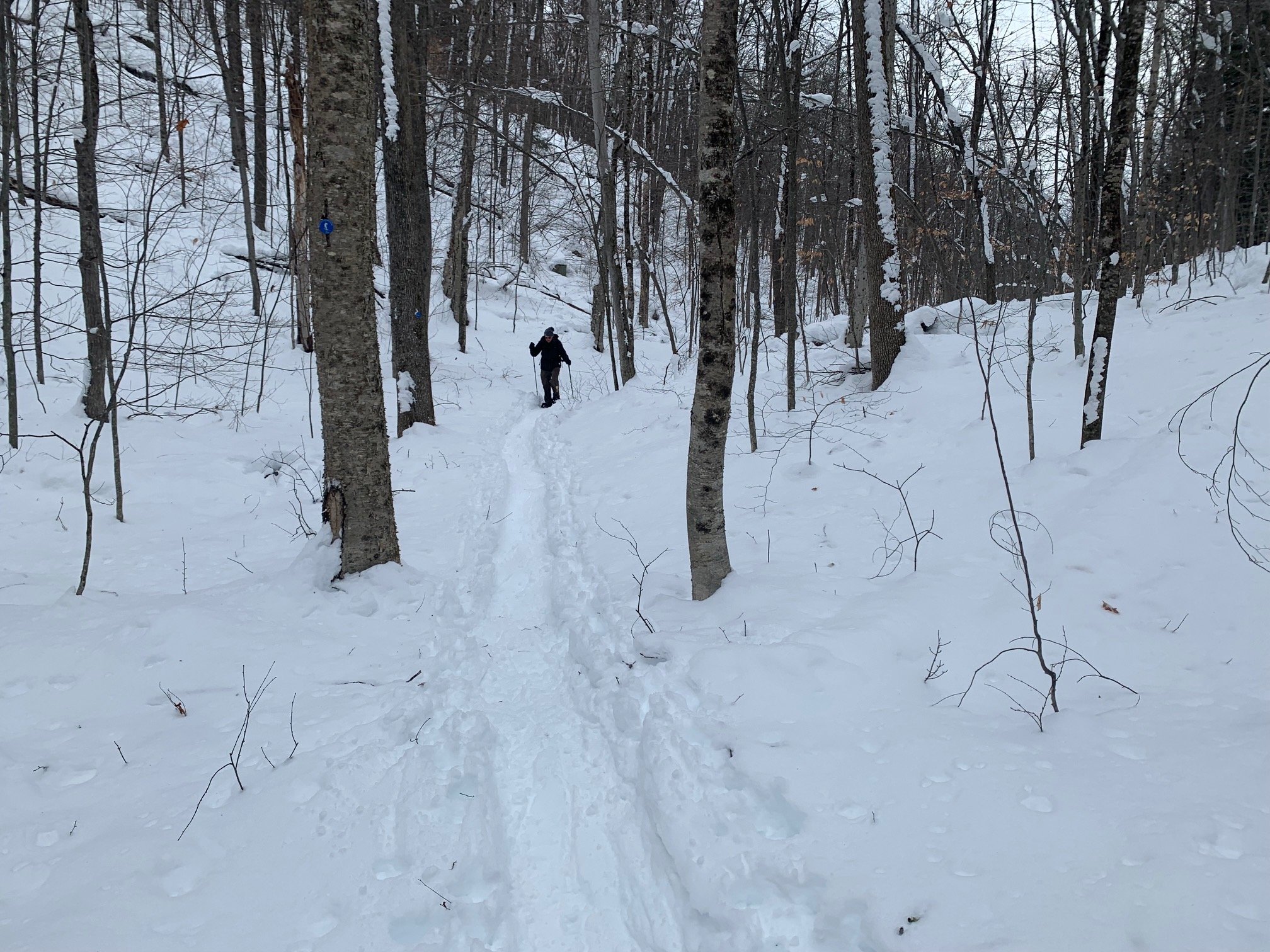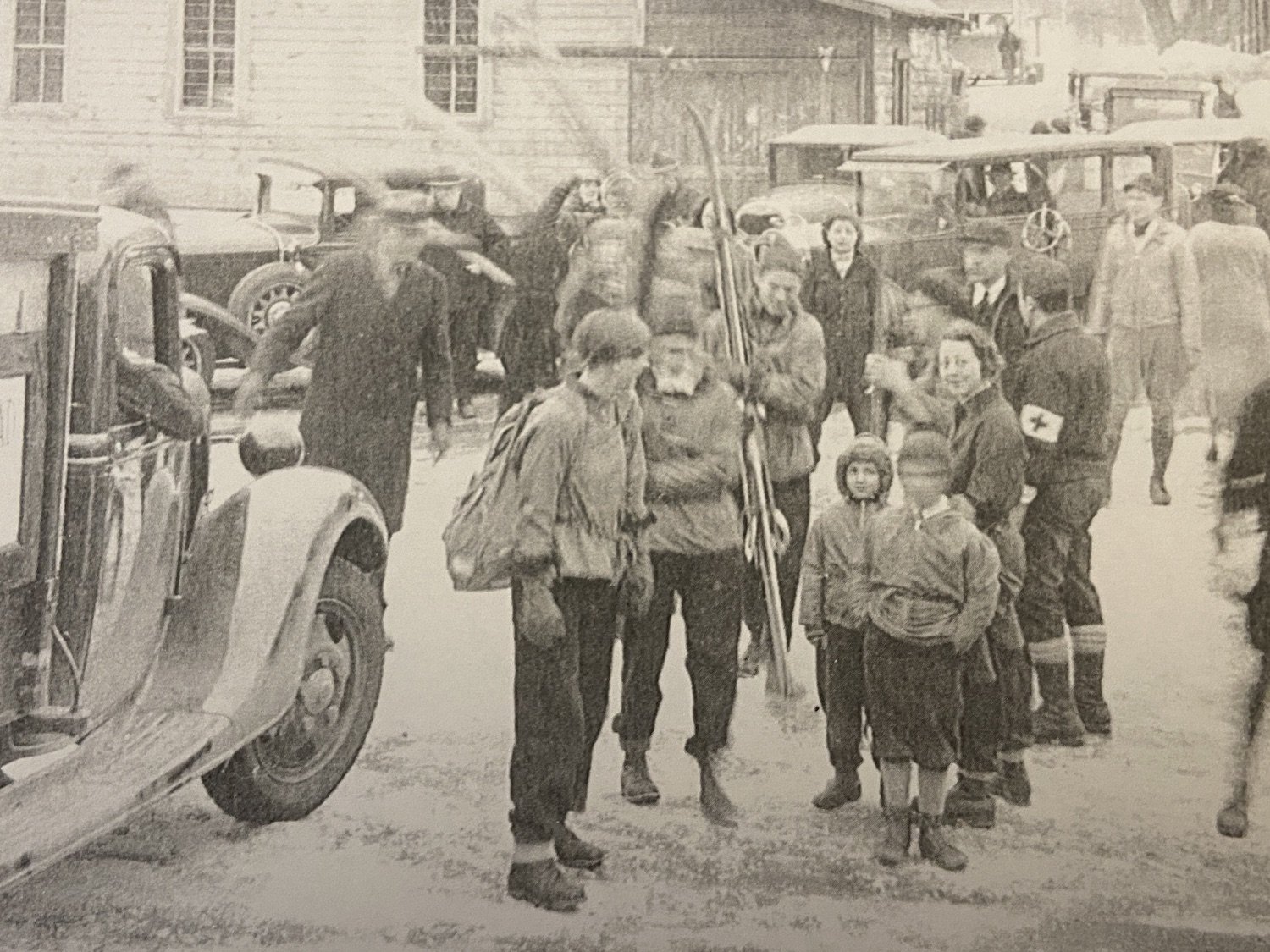Exploring the ‘Sled Shed’
Four of us had training in STQRY today. This is the app by which we’re going to tell stories of western Warren County to visitors on their phones. Think of it as a GPS-triggered podcast that tells stories that relate to where you are. Quite amazing.
We’re used to organizing stories chronologically. Sequentially. One event following another. Now we must organize our stories spatially, by the Points of Interest that trigger the story of the place you’ve just arrived at.
And so, when you arrive at the “Sled Shed,” what story shall we tell you? Who has the starring roles?
And who was Charles Wade?
Lois Perret Schaefer, chair of the First Aid Committee of the Schenectady Wintersports Club, identifies Charles Wade in this recollection as the builder of several first aid huts deployed at “various points” on the trails. “These huts contained first aid supplies, blankets, and sled ambulances.”
“He also built three sled ambulances that were acquired by the Gore Mountain Ski Club,” she wrote.
We thank Jim Schaefer, Lois’s son, for passing this along.
“I think the leaders of the Gore Mountain Ski Club saw the operational challenges of hauling equipment up or down to a strategic location, and it was probably up to Wade to craft these huts and members to install them,” he adds.
If anyone can tell us who Charles Wade was or fill us in on the Gore Mountain Ski Club and the construction of these huts, we’d like to hear from you. Please connect here.
TRIP REPORT
We found the "Sled Shed" three miles in and about a thousand feet of elevation up the northeast shoulder of Gore on the Raymond Brook Trail. Along with the Pete Gay Trail and Rabbit Run, it's used mostly by skiers who start at a higher elevation on Barton Mine Road and come down. But snowshoers are welcome and the Route 28 trailhead about a mile north of the Ski Bowl heading north is a good place to start with ample parking. You also can start at the Ski Bowl but that’s going to add another two miles to your trip. It's a nice, steady incline with only a few short sections that come anywhere close to "steep." The snow was beautiful the day we went in early January.
More About Lois Perret Schaefer
In addition to serving as chair of the Schenectady Wintersports Club's First Aid Committee, Lois (with knapsack) was one of the club's main organizers.
“I was born in East Orange, New Jersey, and looked forward to my summers on Bailey Island near Portsmouth, Maine. That’s where my love of the outdoors began,” writes Lois Perret Schaefer.
As a nurse at St St. Luke's Hospital in New York, she became proficient in treating accident injuries and providing emergency care. When her family moved to Schenectady, she joined them.
"I loved hiking, swimming, skating, and even sail skating so it was only natural that I joined the Mohawk Valley Hiking Club," she writes. "I was thrilled when I was able to buy my own Ford Tin Lizzy in 1919.”
After several members described the fun of skiing in North Creek, she winter vacationed there and got to know many of the locals.
"When Vince Schaefer formed the Schenectady Wintersports Club and talked about creating a snow train I was on board!"
Lois became the club's secretary-treasurer. "Noting my RN and ski skills, Vince asked me to form a First Aid Committee. He had read reports of injuries on other snow trains and hoped to avoid similar situations."
" I thought about what injuries we might expect, what equipment might be needed, and how skiers would need to be transported from the site of their injury on the slopes to the train."
Her committee included Dot Hoyt, who would be named to the 1940 Women’s Olympic Team. [Note: We’d like to find out who else was on this committee. If you know, please pass it along.]
It was in 1936 also that Lois Perret Schaefer issued fanny packs instead of knapsacks to the ten proficient skiers she had enlisted to serve on her ski patrol. This also was the year that Dr. James Glenn "designed and built a wooden box to stabilize leg injuries as the skiers were transported down the mountain, stretched out on a toboggan."
Beginning of the Ski Patrol
"We identified ten expert skiers both from members of our Club and from North Creek High School. We had them take a course in first aid and ski related injuries. The weather didn’t cooperate for our first season, the 1933 ski season. As the Club’s secretary, I sent out cancellation notices over and over, always hoping for better conditions. It was a thankless task! Vince must have appreciated my work because he proposed and we were married in 1935 so the season wasn’t a complete loss!
"The second winter, 1933-34, we headed for North Creek. On March 4, 1934, along with the North Creek Ski Club, I put my plans into action. The safety patrol would carry knapsacks containing first aid kits that the committee had put together. They were assigned to 'patrol' different trails to insure that aid was readily available if needed and they would be recognized by the white armband with a Red Cross logo. More first aid supplies were kept on the train in case of need and a toboggan was stationed on the slopes. A local physician and avid skier, Dr. James Glenn, agreed to be “on call” in case of more serious injury.
"I was concerned that no one be left behind on the slopes, injured or lost, at the end of the day. I arranged to have the first aid skiers patrol the slopes one last time before the train pulled out of the depot. This “trail sweep” became a standard practice. Our first day as a ski patrol was a success! In fact, so was that entire season; no ski injuries were reported. The only injury treated was a cut on the nose due to a skate falling from an overhead rack on the train.
A year after the First Aid Committee was created, the Mt. Mansfield Ski Club in Vermont adopted several procedures that Lois's committee had pioneered. So did Minnie Dole in developing what ultimately would become the National Ski Patrol system we know today.
Additions
As we’re able to locate more details about the early first aid cabins and first Ski Patrol, we’ll add them.
We were intrigued to find the name “C.S. Wade” on this curtain that used to hang in the North Creek Opera House and can now be seen at the Tannery Pond Center.
Here’s more information about the photo we ran above. Note that it was taken on March 10, 1935 by Rae Galusha, who Vince Schaefer describes in Serendipity in Science as a local photographer who would take photos of those coming up on the Snow Train, immediately print them, and sell them at reasonable rates at the end of the day.
We’re also glad to have found this description of the Ski Patrol by the North Creek Depot Museum, which has additional details we may wish to include in our “point of interest” in our StoryMap or Story Cloud.
Many thanks to Bill Schaefer for forward this photo of Lois Perret and Gertrude Schaefer at the North Creek ice rink.










